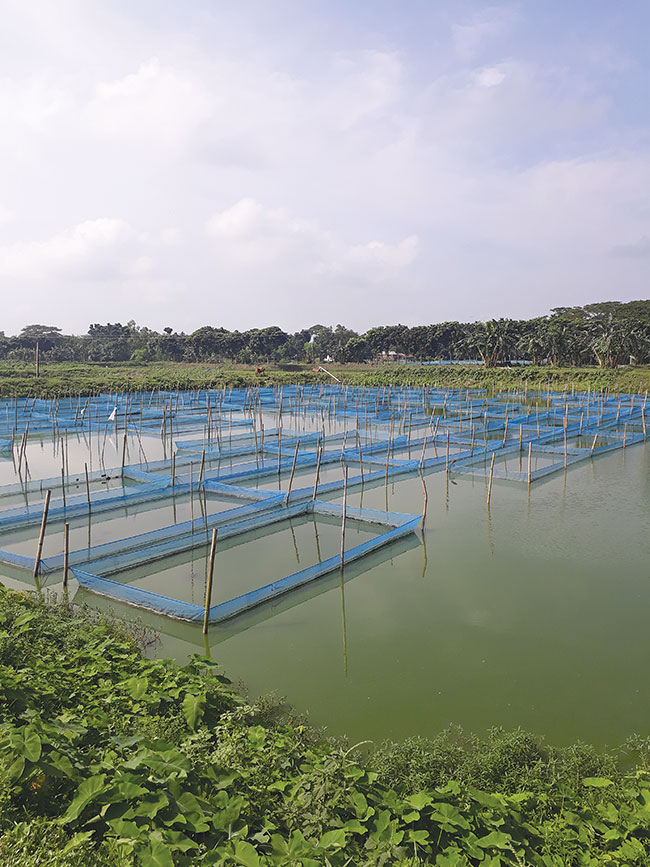
Features
Breeding
Genetics
GIFT is good but some Bangladesh farmers still prefer local strains
January 24, 2022 By Ruby Gonzalez
 Hapas. Tilapia fingerlings are raised in net hapas before being released into ponds, where they are grown for foodfish size.
Photo: Stephanie Horn
Hapas. Tilapia fingerlings are raised in net hapas before being released into ponds, where they are grown for foodfish size.
Photo: Stephanie Horn Genetically-improved farmed tilapia (GIFT) is tried-and-tested but some farmers in Bangladesh still go for local strains. This practise is seen as potentially holding them back economically. There is, however, the other side of economy talks.
Access to better credit may steer low-income tilapia hatchery operators towards producing GIFT.
“It may be hypothesized that poorer farmers lack the capital to invest in more expensive fish seed, commercial fish feed, or other improved farming practices,” Stephanie Horn told Hatchery International. Horn is the corresponding author of the article, ‘Comparative juvenile performance assessment of genetically improved Nile tilapia (Oreochromis niloticus L.) under commercial conditions in Bangladesh’, published in Aquaculture Research.
“Our study suggests there may be a greater propensity for better-off farmers to appreciate the potential benefits of improved strains over poorer farmers,” she said. “However, this has not been explicitly shown in our study and further investigations are required to identify barriers to technology adoption for improved farming practices.”
The research project compared key performance indicators for GIFT and non-GIFT tilapia seed and to investigate fish farmer perceptions of GIFT in Bangladesh.
The good performance of the genetically-improved Nile tilapia emphasized its strengths over the local strain. While the local strain had a significantly higher specific growth rate (SGR) than GIFT during the early nursing trial, come advanced nursing trial, GIFT posted significant higher SGR.
Throughout the early nursing trial, GIFT survival rate was over 88.5 per cent compared to the local strain’s 70.9 per cent. The mean survival rates during the advanced nursing trial were not significantly different. For both trials GIFT had a higher individual weight.
Summarizing, the authors said, “Economic analysis indicated GIFT fish produced a net return 84 per cent greater than that of local strain fish at the end of the early nursing period, and by the end of the advanced nursing period, this difference had grown further such that GIFT generated a gross return over double that of local strain.”
Two strains of tilapia seed were assessed through on-farm trials which compared performance variables of GIFT with a traditional hatchery strain fry during the early nursing and advanced nursing stages of monosex seed production. Production indices and economic performance were investigated.
“GIFT seed is often preferred by farmers as it has been shown to produce higher production yields. There are various genetically improved tilapia strains which are produced by several private and governmental organizations, and tilapia farmers are often aware of the potential benefits of using improved seed – i.e. higher production yields,” she explained.
The authors consistently focused on productivity and said that they had not factored in the reasons that make hatcheries stick to producing local strain fry. Prone to inbreeding, local strains are marked with stunted growth and low value. But demand for this smaller fish has remained strong, especially from people who only have a budget for smaller fish.
The “poorly managed mixed-sex systems” that produce the small fish also produce seeds and, consequently, provide continuous supply that’s less costly to establish and operate.
Print this page
Advertisement
- Indonesian government’s goal to boost aquaculture sector with “aquaculture villages”
- Iran seeks self-sufficiency on broodstock





